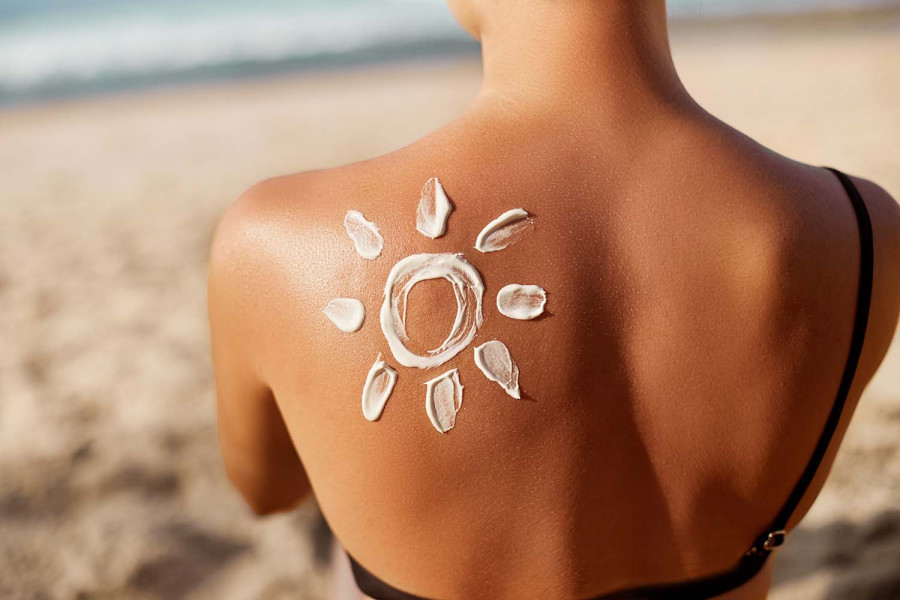Life & Style
The science of sunburn
Dr Suchana Marahatta explains the causes of sunburn, remedies and how it is different from tanning.
Rukusha Giri
The summer months bring in a lot of skin-related issues. The sun’s strong rays can cause tanning and sunburn, making it tough to keep your skin healthy during this time.
Dr Suchana Marahatta, a consultant dermatologist at DI Skin Hospital who specialises in skin surgery and hair transplants, is here to explain sunburn, its causes, potential side effects, and how to prevent it.

She was previously an associate professor at BP Koirala Institute of Health Science.
What is sunburn?
Sunburn occurs when our skin reacts to exposure to UV (ultraviolet) light from the sun. You don’t have to spend the whole day at the beach or pool to get sunburned; you can get sunburned even if you spend a few minutes out in the sun doing minor tasks or activities often. This is why it’s essential to be mindful of your sun exposure whenever you spend time outdoors.
Repeated incidents of sunburn can have serious consequences, including an increased risk of skin cancer and accelerated skin ageing. However, the good news is that by taking daily precautions to safeguard your skin, you can significantly reduce the likelihood of getting sunburned.
Also, there are various types of sunburn. First-degree sunburn only damages the uppermost layer of the skin. This typically heals in a few days to a week. Second-degree sunburn damages the dermis, the middle layer of your skin. During this, blisters will form on the burnt skin and it could take weeks for your skin to heal. This could require medical attention if it seems serious. Third-degree sunburn is very rare and needs immediate attention. It severely impacts the fat layer beneath your skin and all of your skin's layers. Additionally, it can kill nerve endings.
Sunburn typically presents as pink or red, inflamed skin, which can be more challenging to spot on darker skin. Severe sunburn can cause pain, discomfort, itching, and skin swelling. Blisters filled with fluid may also develop and may rupture. In extreme cases, sunburn can cause headaches, fever, nausea, and fatigue.
The role of melanin
The primary determinant of how susceptible one is to sunburn is the amount of melanin pigment present in the skin. Melanin, a natural chemical in the body, is responsible for the pigmentation of our hair, eyes, and skin. When UV rays reach our skin, melanin acts as a shield, preventing these rays from penetrating deeper. The more melanin you produce, the darker your hair, eyes, and skin will be.
However, some individuals may lack sufficient melanin pigment to adequately protect their skin, making them more vulnerable to sunburn. Skin type also plays a significant role, with Skin Types 1 and 2 being highly susceptible, especially in individuals with fair or Western skin. Skin colour differences also contribute to varying degrees of sunburn risk.
Tanning vs sunburn
It’s essential to differentiate between tanning and sunburn, as they represent two distinct skin reactions to UV exposure. While both involve the skin’s response to UV rays, they vary based on an individual’s skin type. Lighter skin types are more prone to sunburn, while darker skin types tend to experience more tanning.
Sunburn is characterised by redness, blistering, peeling, and hyperpigmentation, resulting from the skin’s inflammatory response to UVB rays, which constitute a small portion of the sun's UV radiation. Sunburn should be taken seriously as it can cause long-term skin issues, such as premature ageing and an increased risk of skin cancer.
Tanning, on the other hand, is the skin’s natural way of defending itself against UVA rays. When exposed to UVA rays, the skin produces melanin, which darkens the skin. Tanning is a slower process than sunburn and is generally less harmful. However, any change in skin colour due to UV exposure indicates skin damage, so protection from both UVA and UVB rays is essential for maintaining healthy skin.
Controlling sunburn
Preventing sunburn involves understanding how it occurs and taking appropriate measures. Some ways to control sunburn are:
Applying sunscreen correctly and reapplying every three hours while outdoors.
If you notice yourself getting a sunburn, cool the skin by applying ice or moving out of the sun.
Take cold showers to soothe the skin.
Once the skin is cooled, apply ointments like antibiotics or petroleum jelly to heal without scarring.
Use aloe vera gel to ease itching.
Moisturise frequently to combat dryness caused by sunburn. Use topical cooling and hydrating products, such as hydrocortisone cream.
Stay well-hydrated to prevent skin-related complications.




 16.12°C Kathmandu
16.12°C Kathmandu










